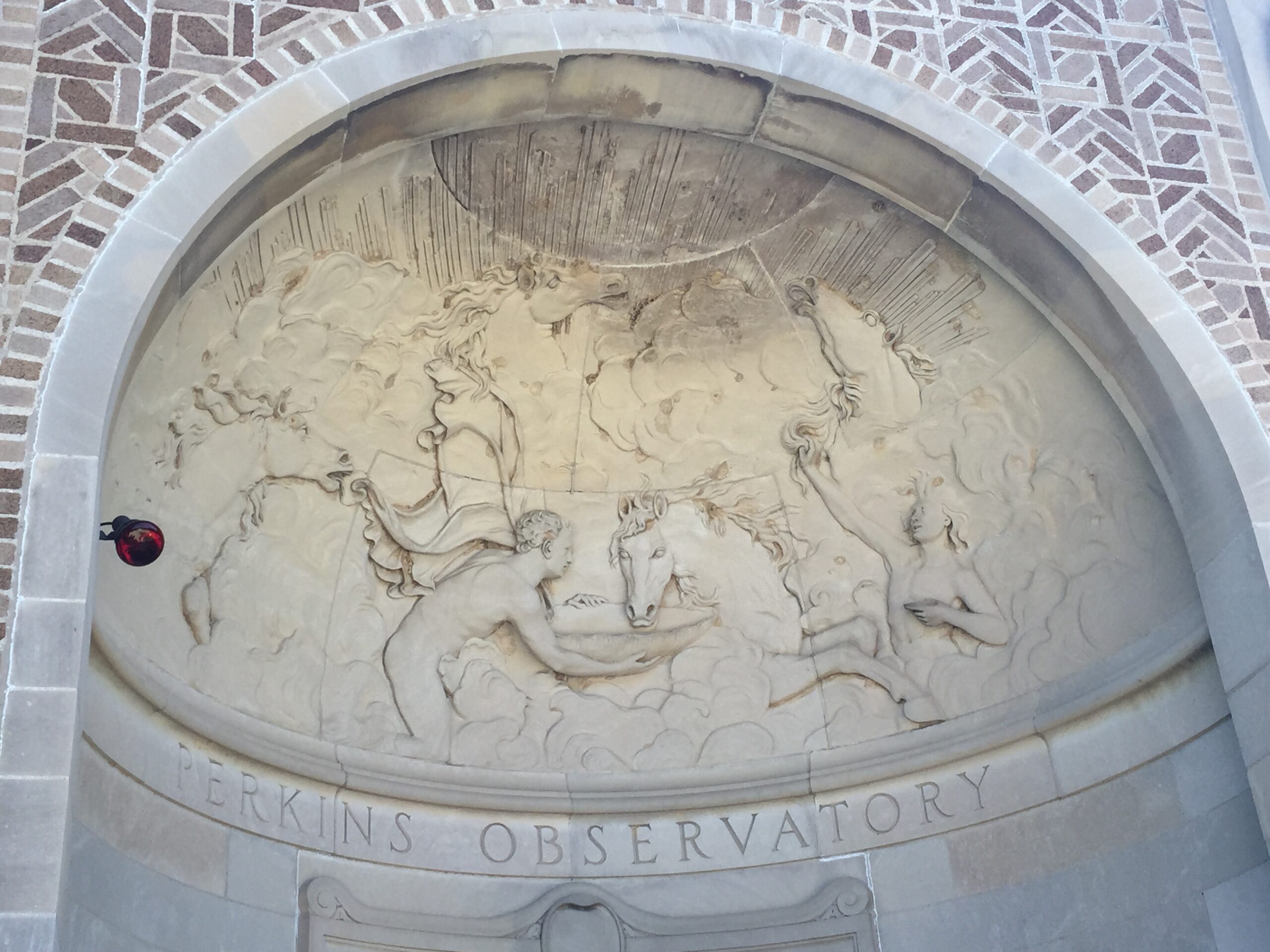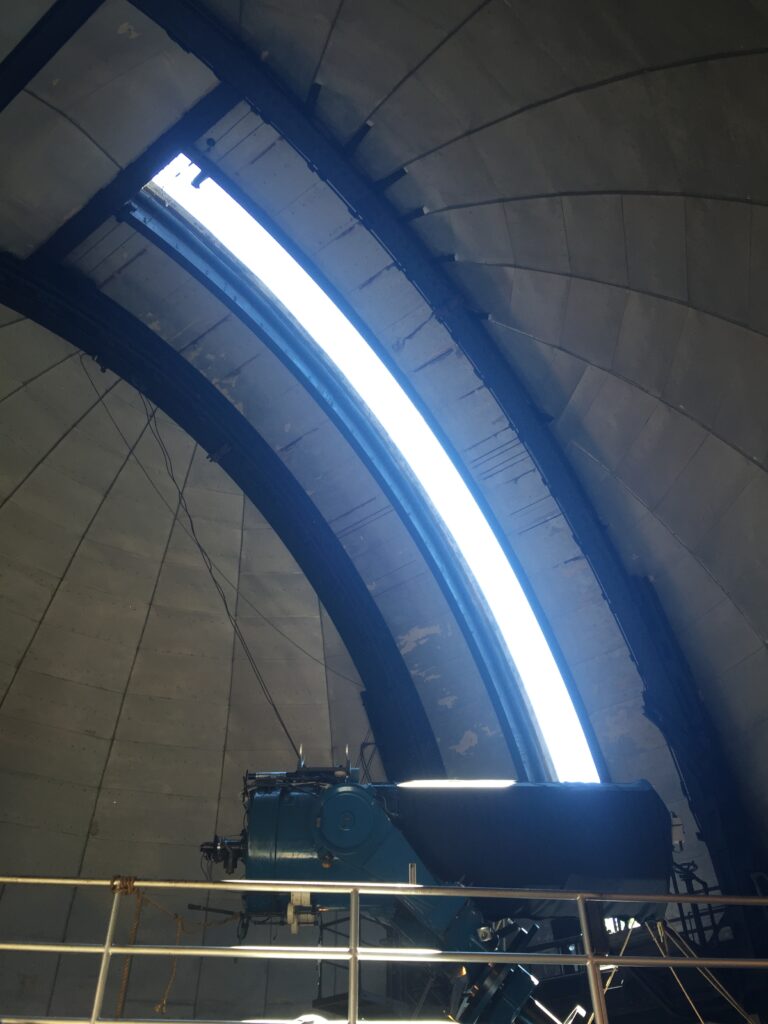Stargazing is an amazing way to spend an evening.
I got to do just that recently thanks to Perkins Observatory‘s public astronomy program.
Last Friday night, I drove up to Ohio Wesleyan University’s 100-year-old observatory just before 9 pm to observe the night sky with a remarkable telescope – the second largest in Ohio.
Located in Delaware just off Route 23, the Perkins Observatory is an impressive old building at the top of a grassy green hill.
Z and I visited the observatory for the first time on a summer field trip years ago, back when she was still in daycare. It just happened to take place on a day when I could tag along as a parent chaperone.
I really enjoyed that daytime program. We learned about astronomy, toured the observatory’s upper rotating dome room, looked at our day-star (aka the sun) through a special telescope, and watched quirky scientists launch model rockets outside on the lawn. I think the teachers and I enjoyed it even more than the kids; I made a mental note to go back sometime when Z was older.
Alas, this time my fam decided to give Perkins a raincheck, but I am so glad I went anyway.
Space is so cool. I’ve always loved the stargazing programs available at planetariums – including our own magical COSI planetarium – but there’s nothing quite like seeing the real thing through your very own eyes, with the help of an enormous telescope, of course.
I anticipated that our whole fam would like the Friday night astronomy program at Perkins because we all really enjoyed our visit to NASA’s Kennedy Space Center a few years back (I personally think Ariana Grande may have boosted young people’s interest in NASA that year thanks to her popular song.)
Perkins Observatory is a little-known treasure in central Ohio and I’m so glad I finally got to check out their nighttime program, which takes place on Friday nights throughout summer.
The public programs at Perkins only cost $10 per person, but they are not easy to get into. Obtaining tickets is done through a rather convoluted, multi-step process that goes like this:
- You have to call the observatory (740-363-1257) and listen to a long voicemail message from Don Stevens, astrophysicist and director of the Perkins Observatory.
- You leave a message with your name, number and the date when you’d like tickets.
- Don then calls you back and confirms whether there are spots open on the night you’ve chosen – or he may suggest an alternate night. He also asks for your email address. **This was the hardest part of the process for me. Any unknown number goes straight to voicemail on my phone. I had to add him as a contact and leave messages asking him repeatedly to call me back before I could get to the next step!**
- Don sends you an email with a link to purchase your tickets.
- Last, but not least, you have to email Don back to let him know you’ve paid for the tickets.
The public programs are largely weather-dependent. On the night that I went, we had pretty good visibility but there was quite a bit of light pollution which cut down on the clarity of what we could see through the telescopes.
The evening began with Don speaking to the group about some astronomy basics and what we’d likely see through the telescopes. Then, we all went outside to take turns looking through four or five powerful telescopes belonging to volunteers from the Columbus Astronomical Society. These folks give up their Friday nights all summer long to help newbies see stars and learn more about astronomy – how cool is that?
After stargazing out on the lawn, the group returned inside and climbed up the stairs into the Perkins Observatory’s upper dome. There, we each got a turn to look through the observatory’s 32″ Schottland telescope – which is actually a lot bigger than it sounds. The domed room was very dark, lit only by amber-colored Christmas lights to protect our night vision. It felt like being in a spaceship.
In addition to seeing super cool stars, star pairs, nebulas and globular star clusters up close, I learned some pretty cool things about astronomy. For one, I learned that you can see some amazing sights in the night sky with a simple pair of binoculars.
Did you know that you could use binoculars to look at the heavens at night? Of course, if you live in an area with lots of light pollution (hi, Columbus, and all other major metropolitan areas), you’ll be somewhat limited. But I can’t wait to take our binoculars next time we spend a night in Hocking Hills or another rural, low-light area.
I also learned that although there are cool astronomy apps available for smartphones, it’s best not to look at your phone at all when you’re trying to see stars. The screen messes with your night vision even if you turn your brightness all the way down.
Who’s ready to head out for parts unknown, leave our phones in the car and use binoculars to scout out stars, planets and galaxies far, far away? I definitely am!
But if seeing stars closer to home sounds good too, then be sure to head to Perkins Observatory soon for an evening with local astrophysicists and astronomers. Just be sure to get tickets first, as only those with tickets for a public program are permitted on the grounds.




